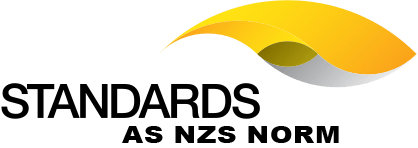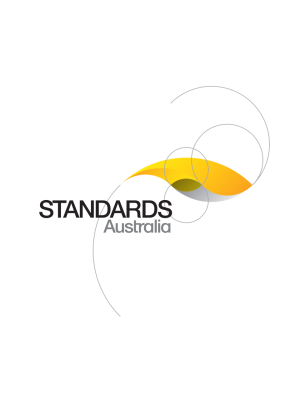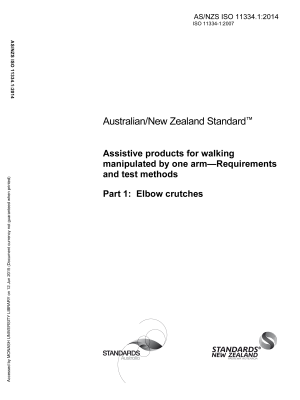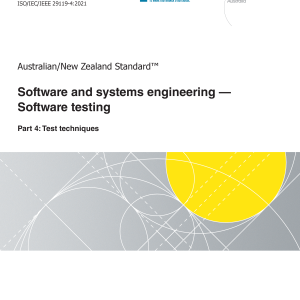🔍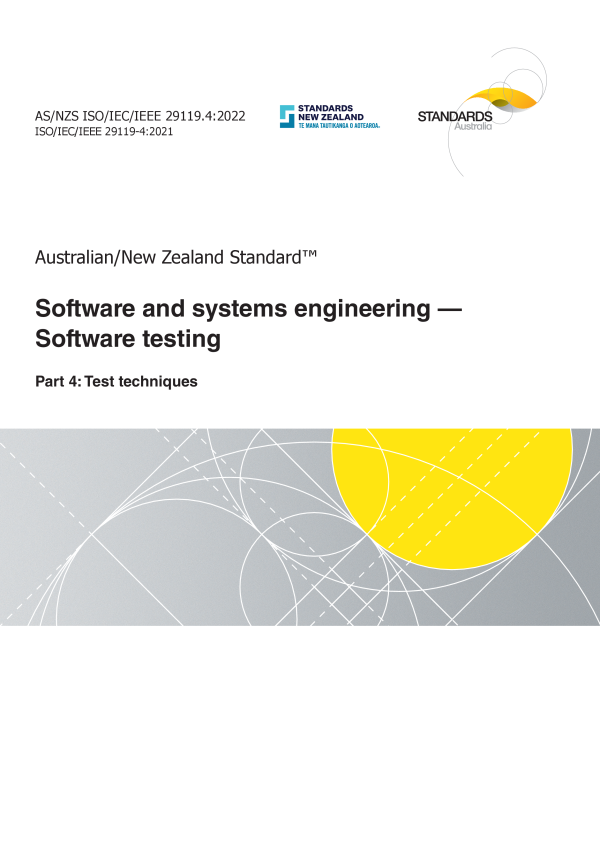

Purchase the full subscription package now and enjoy a 40% discount, along with free updates for future editions.
AS/NZS ISO/IEC/IEEE 29119.4:2022
$321.76
Software and systems engineering – Software testing, Part 4: Test techniques
AS/NZS ISO/IEC/IEEE 29119.4:2022 identically adopts ISO/IEC/IEE 29119-4:2021, which defines test design techniques that can be used during the test design and implementation process that is defined in AS/NZS ISO/IEC/IEEE 29119.2:2022. Each technique follows the test design and implementation process that is defined in AS/NZS ISO/IEC/IEEE 29119.2:2022.
Table of contents
Header
About this publication
Preface
Foreword
Introduction
1 Scope
2 Normative references
3 Terms and definitions
4 Conformance
4.1 Intended usage
4.2 Full conformance
4.3 Tailored conformance
5 Test design techniques
5.1 Overview
5.2 Specification-based test design techniques
5.2.1 Equivalence partitioning
5.2.1.1 General
5.2.1.2 Create test model (TD1)
5.2.1.3 Identify test coverage items (TD2)
5.2.1.4 Derive test cases (TD3)
5.2.2 Classification tree method
5.2.2.1 Create test model (TD1)
5.2.2.2 Identify test coverage items (TD2)
5.2.2.3 Derive test cases (TD3)
5.2.3 Boundary value analysis
5.2.3.1 Create test model (TD1)
5.2.3.2 Identify test coverage items (TD2)
5.2.3.3 Derive test cases (TD3)
5.2.4 Syntax testing
5.2.4.1 Create test model (TD1)
5.2.4.2 Identify test coverage items (TD2)
5.2.4.3 Derive test cases (TD3)
5.2.5 Combinatorial test design techniques
5.2.5.1 Overview
5.2.5.2 Create test model (TD1)
5.2.5.3 All combinations testing
5.2.5.3.1 Identify test coverage items (TD2)
5.2.5.3.2 Derive test cases (TD3)
5.2.5.4 Pair-wise testing
5.2.5.4.1 Identify test coverage items (TD2)
5.2.5.4.2 Derive test cases (TD3)
5.2.5.5 Each choice testing
5.2.5.5.1 Identify test coverage items (TD2)
5.2.5.5.2 Derive test cases (TD3)
5.2.5.6 Base choice testing
5.2.5.6.1 Identify test coverage items (TD2)
5.2.5.6.2 Derive test cases (TD3)
5.2.6 Decision table testing
5.2.6.1 Create test model (TD1)
5.2.6.2 Identify test coverage items (TD2)
5.2.6.3 Derive test cases (TD3)
5.2.7 Cause-effect graphing
5.2.7.1 Create test model (TD1)
5.2.7.2 Identify test coverage items (TD2)
5.2.7.3 Derive test cases (TD3)
5.2.8 State transition testing
5.2.8.1 Create test model (TD1)
5.2.8.2 Identify test coverage items (TD2)
5.2.8.3 Derive test cases (TD3)
5.2.9 Scenario testing
5.2.9.1 Create test model (TD1)
5.2.9.2 Identify test coverage items (TD2)
5.2.9.3 Derive test cases (TD3)
5.2.10 Random testing
5.2.10.1 Create test model (TD1)
5.2.10.2 Identify test coverage items (TD2)
5.2.10.3 Derive test cases (TD3)
5.2.11 Metamorphic testing
5.2.11.1 Create test model (TD1)
5.2.11.2 Identify test coverage items (TD2)
5.2.11.3 Derive test cases (TD3)
5.2.12 Requirements-based testing
5.2.12.1 Create test model (TD1)
5.2.12.2 Identify test coverage items (TD2)
5.2.12.3 Derive test cases (TD3)
5.3 Structure-based test design techniques
5.3.1 Statement testing
5.3.1.1 Create test model (TD1)
5.3.1.2 Identify test coverage items (TD2)
5.3.1.3 Derive test cases (TD3)
5.3.2 Branch testing
5.3.2.1 Create test model (TD1)
5.3.2.2 Identify test coverage items (TD2)
5.3.2.3 Derive test cases (TD3)
5.3.3 Decision testing
5.3.3.1 Create test model (TD1)
5.3.3.2 Identify test coverage items (TD2)
5.3.3.3 Derive test cases (TD3)
5.3.4 Branch condition testing
5.3.4.1 Create test model (TD1)
5.3.4.2 Identify test coverage items (TD2)
5.3.4.3 Derive test cases (TD3)
5.3.5 Branch condition combination testing
5.3.5.1 Create test model (TD1)
5.3.5.2 Identify test coverage items (TD2)
5.3.5.3 Derive test cases (TD3)
5.3.6 Modified condition/decision coverage (MCDC) testing
5.3.6.1 Create test model (TD1)
5.3.6.2 Identify test coverage items (TD2)
5.3.6.3 Derive test cases (TD3)
5.3.7 Data flow testing
5.3.7.1 Create test model (TD1)
5.3.7.2 All-definitions testing
5.3.7.2.1 Identify test coverage items (TD2)
5.3.7.2.2 Derive test cases (TD3)
5.3.7.3 All-c-uses testing
5.3.7.3.1 Identify test coverage items (TD2)
5.3.7.3.2 Derive test cases (TD3)
5.3.7.4 All-p-uses testing
5.3.7.4.1 Identify test coverage items (TD2)
5.3.7.4.2 Derive test cases (TD3)
5.3.7.5 All-uses testing
5.3.7.5.1 Identify test coverage items (TD2)
5.3.7.5.2 Derive test cases (TD3)
5.3.7.6 All-du-paths testing
5.3.7.6.1 Identify test coverage items (TD2)
5.3.7.6.2 Derive test cases (TD3)
5.4 Experience-based test design techniques
5.4.1 Error guessing
5.4.1.1 Create test model (TD1)
5.4.1.2 Identify test coverage items (TD2)
5.4.1.3 Derive test cases (TD3)
6 Test coverage measurement
6.1 Overview
6.2 Test measurement for specification-based test design techniques
6.2.1 Equivalence partition coverage
6.2.2 Classification tree method coverage
6.2.3 Boundary value analysis coverage
6.2.4 Syntax testing coverage
6.2.5 Combinatorial test design techniques coverage
6.2.5.1 All combinations testing coverage
6.2.5.2 Pair-wise testing coverage
6.2.5.3 Each choice testing coverage
6.2.5.4 Base choice testing coverage
6.2.6 Decision table testing coverage
6.2.7 Cause-effect graphing coverage
6.2.8 State transition testing coverage
6.2.9 Scenario testing coverage
6.2.10 Random testing coverage
6.2.11 Metamorphic testing coverage
6.2.12 Requirements-based testing coverage
6.3 Test measurement for structure-based test design techniques
6.3.1 Statement testing coverage
6.3.2 Branch testing coverage
6.3.3 Decision testing coverage
6.3.4 Branch condition testing coverage
6.3.5 Branch condition combination testing coverage
6.3.6 Modified condition/decision coverage (MCDC)
6.3.7 Data flow testing coverage
6.3.7.1 All-definitions testing coverage
6.3.7.2 All-c-uses testing coverage
6.3.7.3 All-p-uses testing coverage
6.3.7.4 All-uses testing coverage
6.3.7.5 All-du-paths testing coverage
6.4 Test measurement for experience-based testing design techniques — Error guessing coverage
Annex A
A.1 Quality characteristics
A.2 Quality-related types of testing
A.2.1 Accessibility testing
A.2.2 Compatibility testing
A.2.3 Conversion testing
A.2.4 Disaster/recovery testing
A.2.5 Functional testing
A.2.6 Installability testing
A.2.7 Interoperability testing
A.2.8 Localization testing
A.2.9 Maintainability testing
A.2.10 Performance-related testing
A.2.11 Portability testing
A.2.12 Procedure testing
A.2.13 Reliability testing
A.2.14 Security testing
A.2.15 Usability testing
A.3 Mapping quality characteristics to types of testing
A.4 Mapping quality characteristics to test design techniques
Annex B
B.1 Guidelines and examples for specification-based testing
B.1.1 Overview
B.2 Specification-based test design technique examples
B.2.1 Equivalence partitioning
B.2.1.1 Test basis
B.2.1.2 Determine required test coverage
B.2.1.3 Create test model (TD1)
B.2.1.4 Identify test coverage items (TD2)
B.2.1.5 Derive test cases (TD3)
B.2.1.5.1 General
B.2.1.5.2 Option a: derive test cases for one-to-one equivalence partitioning
B.2.1.5.3 Option b: derive test cases for minimized equivalence partitioning
B.2.2 Classification tree method
B.2.2.1 Test basis
B.2.2.2 Determine required test coverage
B.2.2.3 Create test model (TD1)
B.2.2.4 Identify test coverage items (TD2)
B.2.2.5 Derive test cases (TD3)
B.2.2.6 Classification tree method coverage
B.2.3 Boundary value analysis
B.2.3.1 General
B.2.3.2 Test basis
B.2.3.3 Determine required test coverage
B.2.3.4 Create test model (TD1)
B.2.3.5 Identify test coverage items (TD2)
B.2.3.6 Derive test cases (TD3)
B.2.3.7 Boundary Value Analysis Coverage
B.2.4 Syntax testing
B.2.4.1 General
B.2.4.2 Test basis
B.2.4.3 Determine required test coverage
B.2.4.4 Create test model (TD1)
B.2.4.5 Identify test coverage items (TD2)
B.2.4.6 Derive test cases (TD3)
B.2.4.7 Syntax testing coverage
B.2.5 Combinatorial test design techniques
B.2.5.1 General
B.2.5.2 Test basis
B.2.5.3 Determine required test coverage
B.2.5.4 Create test model (TD1)
B.2.5.5 All combinations
B.2.5.5.1 Identify test coverage items (TD2)
B.2.5.5.2 Derive test cases (TD3)
B.2.5.5.3 All combinations testing coverage
B.2.5.6 Pair-wise testing
B.2.5.6.1 Identify test coverage items (TD2)
B.2.5.6.2 Derive test cases (TD3)
B.2.5.6.3 Pair-wise testing coverage
B.2.5.7 Each choice testing
B.2.5.7.1 Identify test coverage items (TD2)
B.2.5.7.2 Derive test cases (TD3)
B.2.5.7.3 Each choice testing coverage
B.2.5.8 Base choice testing
B.2.5.8.1 Identify test coverage items (TD2)
B.2.5.8.2 Derive test cases (TD3)
B.2.5.8.3 Base choice testing coverage
B.2.6 Decision table testing
B.2.6.1 General
B.2.6.2 Test basis
B.2.6.3 Determine required test coverage
B.2.6.4 Create test model (TD1)
B.2.6.5 Identify test coverage items (TD2)
B.2.6.6 Derive test cases (TD3)
B.2.6.7 Decision table testing coverage
B.2.7 Cause-effect graphing
B.2.7.1 General
B.2.7.2 Test basis
B.2.7.3 Determine required test coverage
B.2.7.4 Create test model (TD1)
B.2.7.5 Identify test coverage items (TD2)
B.2.7.6 Derive test cases (TD3)
B.2.7.7 Cause-effect graphing coverage
B.2.8 State transition testing
B.2.8.1 General
B.2.8.2 Test basis
B.2.8.3 Determine required test coverage
B.2.8.4 Create test model (TD1)
B.2.8.4.1 General
B.2.8.4.2 Test model for achieving switch coverage
B.2.8.4.3 Test model for achieving all transition coverage
B.2.8.5 Identify test coverage items for 0-switch coverage (TD2)
B.2.8.6 Derive test cases for 0-switch coverage (TD3)
B.2.8.7 Identify test coverage items for all transitions coverage (TD2)
B.2.8.8 Derive test cases for all transitions coverage (TD3)
B.2.8.9 Identify test coverage items – 1-switch testing (TD2)
B.2.8.10 Derive test cases for 1-switch coverage (TD3)
B.2.8.11 State transition testing coverage
B.2.9 Scenario testing
B.2.9.1 General
B.2.9.2 Scenario testing – example 1
B.2.9.2.1 Test basis
B.2.9.2.2 Determine required test coverage
B.2.9.2.3 Create test model (TD1)
B.2.9.2.4 Identify test coverage items (TD2)
B.2.9.2.5 Derive test cases (TD3)
B.2.9.2.6 Scenario testing coverage
B.2.9.3 Scenario testing – example 2
B.2.9.3.1 General
B.2.9.3.2 Test basis
B.2.9.3.3 Determine required rest coverage
B.2.9.3.4 Create test model (TD1)
B.2.9.3.5 Identify test coverage items (TD2)
B.2.9.3.6 Derive test cases (TD3)
B.2.9.3.7 Use case testing coverage
B.2.10 Random testing
B.2.10.1 General
B.2.10.2 Test basis
B.2.10.3 Determine required test coverage
B.2.10.4 Create test model (TD1)
B.2.10.5 Identify test coverage items (TD2)
B.2.10.6 Derive test cases (TD3)
B.2.10.7 Random testing coverage
B.2.10.8 Automating random testing
B.2.11 Metamorphic testing
B.2.11.1 General
B.2.11.2 Test basis
B.2.11.3 Determine required test coverage
B.2.11.4 Create test model (TD1)
B.2.11.5 Identify test coverage items (TD2)
B.2.11.6 Derive test cases (TD3)
B.2.11.7 Metamorphic testing coverage
B.2.12 Requirements-based testing
B.2.12.1 General
B.2.12.2 Test basis
B.2.12.3 Determine required test coverage
B.2.12.4 Create test model (TD1)
B.2.12.5 Identify test coverage items (TD2)
B.2.12.6 Derive test cases (TD3)
B.2.12.7 Requirements-based testing coverage
Annex C
C.1 Guidelines and examples for structure-based testing
C.1.1 Overview
C.2 Structure-based test design technique examples
C.2.1 Statement testing
C.2.1.1 General
C.2.1.2 Test basis
C.2.1.3 Create test model (TD1)
C.2.1.4 Identify test coverage items (TD2)
C.2.1.5 Derive test cases (TD3)
C.2.1.6 Statement testing coverage
C.2.2 Branch/decision testing
C.2.2.1 General
C.2.2.2 Test basis
C.2.2.3 Create test model (TD1)
C.2.2.4 Identify test coverage items (TD2)
C.2.2.4.1 Options for identification of test coverage items
C.2.2.4.2 Option a: identify test coverage items for branch coverage
C.2.2.4.3 Option b: identify test coverage items for decision coverage
C.2.2.5 Derive test cases (TD3)
C.2.2.6 Branch testing coverage
C.2.2.7 Decision testing coverage
C.2.3 Branch condition testing, branch condition combination testing and modified condition/decision coverage (MCDC) testing
C.2.3.1 General
C.2.3.2 Test basis
C.2.3.3 Create test model (TD1)
C.2.3.4 Branch condition testing
C.2.3.4.1 Identify test coverage items (TD2)
C.2.3.4.2 Derive test cases (TD3)
C.2.3.4.3 Branch condition testing coverage
C.2.3.5 Branch condition combination testing
C.2.3.5.1 Identify test coverage items (TD2)
C.2.3.5.2 Derive test cases (TD3)
C.2.3.5.3 Branch condition combination testing coverage
C.2.3.6 Modified condition/decision coverage testing
C.2.3.6.1 General
C.2.3.6.2 Identify test coverage items (TD2)
C.2.3.6.3 Derive test cases (TD3)
C.2.3.6.4 Modified condition/decision coverage
C.2.3.7 Other Boolean expressions
C.2.3.8 Optimised expressions
C.2.3.9 Other branches and decisions
C.2.4 Data flow testing
C.2.4.1 General
C.2.4.2 Test basis
C.2.4.3 Create test model (TD1)
C.2.4.4 All-definitions testing
C.2.4.4.1 Identify test coverage items for all-definitions testing (TD2)
C.2.4.4.2 Derive test cases for all-definitions testing (TD3)
C.2.4.4.3 All-definitions testing coverage
C.2.4.5 All-c-uses testing
C.2.4.5.1 Identify test coverage items for all-c-uses testing (TD2)
C.2.4.5.2 Derive test cases for all-c-uses Testing (TD3)
C.2.4.5.3 All-c-uses testing coverage
C.2.4.6 All-p-uses testing
C.2.4.6.1 Identify test coverage items for all-p-uses testing (TD2)
C.2.4.6.2 Derive test cases for all-p-uses testing (TD3)
C.2.4.6.3 All-p-uses testing coverage
C.2.4.7 All-uses testing
C.2.4.7.1 Identify test coverage items for all-uses testing (TD2)
C.2.4.7.2 Derive test cases for all-uses testing (TD3)
C.2.4.7.3 All-uses testing coverage
C.2.4.8 All-du-paths testing
C.2.4.8.1 Identify test coverage items for all-du-paths testing (TD2)
C.2.4.8.2 Derive test cases for all-du-paths testing (TD3)
C.2.4.8.3 All-du-paths testing coverage
Annex D
D.1 Guidelines and examples for experience-based testing
D.1.1 Overview
D.2 Experience-based test design technique examples
D.2.1 Error guessing
D.2.1.1 General
D.2.1.2 Test basis
D.2.1.3 Create test model (TD1)
D.2.1.4 Identify test coverage items (TD2)
D.2.1.5 Derive test cases (TD3)
D.2.1.6 Error guessing test coverage
Annex E
E.1 Guidelines and examples for grey-box test design techniques
E.1.1 Overview
E.1.2 Branch testing as a specification-based technique
E.1.2.1 Test basis
E.1.2.2 Create test model (TD1)
E.1.2.3 Identify test coverage items (TD2)
E.1.2.4 Derive test cases (TD3)
E.1.2.5 Branch testing coverage
Annex F
Annex G
Annex H
Bibliography
IEEE Notices and Abstract
Cited references in this standard
Content history
[Current]
[Superseded]
DR AS/NZS ISO/IEC/IEEE 29119.4:2022
Please select a variation to view its description.
| Published | 27/05/2022 |
|---|---|
| Pages | 139 |
Please select a variation to view its pdf.
